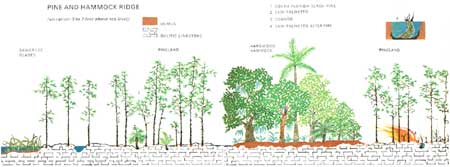|
EVERGLADES National Park |
 |
AMERICA'S SUBTROPICAL WONDERLAND
Pine Rockland
There is another condition essential to the survival of the pine forest in this region—fire. We usually think of fire as the enemy of forest vegetation; but that is not true here. The pines that grow in this part of Florida have a natural resistance to fire. Their thick, corky bark insulates their trunks from the flames. And strangely enough the fire actually seems to help with pine reproduction; it destroys competing vegetation and exposes the mineral soil seedlings need. If there has been a good cone crop, you will find an abundant growth of pine seedlings after a fire in the pinelands.
What would happen if the pinelands were protected from fire? Examine a pine forest where there have been no recent fires. You will note that there are many small hardwood (broadleaved) trees growing in the shade of the pines. These hardwoods would eventually shade out the light-demanding pine seedlings, and take over as the old pines died off. But under normal conditions, lightning-caused fires sweep at fairly frequent intervals through the pineland. Since the young hardwoods have little resistance to fire, they are wiped out.
Before this century, fires burned vast areas. The only barriers were natural waterways—sloughs, lakes and ponds, and estuaries—which retained some water during the rainless season when the rest of the glades and pinelands dried up. Old-timers say that sometimes a fire would travel all the way from Lake Okeechobee to the coastal prairie of Cape Sable (see page 2). In the pine forest, any area bypassed by these fires for a lengthy period developed into a junglelike island of hardwoods. We call such stands "hammocks," whether they develop in the pine forest or in the open glades. On the limestone ridge, the hammocks support a community of plants and animals strikingly different from the surrounding pine forests.
With the opening up of south Florida for farming and industry, man's works—particularly roads and canals—soon crisscrossed the region, forming barriers to the spread of the fires. Suppression of fire by farmers, lumbermen, and park managers also lessened their effect. Thus the hardwoods, which previously had been held back by fire, tended to replace the pines. And although the park was established to preserve a patch of primitive subtropical America as it was in earlier centuries, the landscape began to change.
Continued protection of the park from fire would in time eliminate the pineland—a plant community that has little chance to survive elsewhere. So, in Everglades National Park, Smokey Bear must take a back seat: park rangers deliberately set fires to help nature maintain the natural scene. Thus, as you drive down the road to Flamingo, do not be shocked to discover park rangers burning the vegetation. The fires are controlled, of course, and the existing hammocks are not destroyed.
When you visit the park take a close look at the pinelands community. Notice, as you walk on the manmade trail through the pine forest, that the ground on either side of you is extremely rough. The limestone bedrock is visible everywhere; what soil there is has accumulated in the pits and potholes that riddle the bedrock. The trees, shrubs, grasses, and other plants are rooted in these pockets of soil.
The limestone looks rather hazardous to walk on#151;and it is. You must be careful not to break through a thin shell of rock covering a cavity. This pitted, honeycombed condition is due to the fact that the limestone is easily dissolved by acids. Decaying pine needles, palmetto leaves, and other dead plant materials produce weak acids that continually eat away at the rock.
If a fire has passed through the pineland recently, you may notice that while most of the low-growing plants have been killed, some, such as the saw-palmetto, are sending up new green shoots. The thick, stubby stem of the palmetto lies in a pothole, with its roots in the soil that has accumulated there; even in the dry season the pocket in the limestone remains damp, for water is never very far below the surface in this region. When fire kills the top of the plant, the stem and roots survive, and the palmetto, like the pine, remains a part of the plant community.
A number of other plants of the south Florida pinelands have adapted to the conditions of periodic burning. Coontie (a cycad, from the underground stems of which the Indians made flour) and moon vine (a morningglory) are among many you will see surviving pineland fires severe enough to result in the death or stunting of the hardwood seedlings and saplings.
Sometimes we forget that fire—like water, wind, and sunlight—is a natural force that operates with the others to influence the evolution of plants as well as to shape the landscape.
The pineland, like other plant communities, has its own community of animals. Some of its residents, such as the cotton mouse, opossum, and raccoon, are found in other communities of the park, too.
Some of the pineland animals, however—pine warbler, reef gecko, and five-lined skink, for example—are particularly adapted to this environment. These lovers of sunlight are dependent, like the pine forest, on the occasional natural or manmade fires that hold back the hardwood trees.
The pine rockland is quite different from the other plant-and-animal communities you will see as you drive through the park: it is the only ecosystem you can explore on foot in any season. Other parts of the park are largely flooded during the wet season. Elevated boardwalks have been provided in some of these areas to enable you to penetrate them a short distance from the road.
As you will see, fire plays an important role in some of the other Everglades communities, too.

|

|
| NPS History | History & Culture | National Park Service | Contact |
|
Last Modified: Sat, Nov 4 2006 10:00:00 pm PST |



